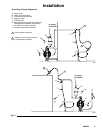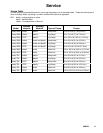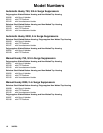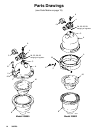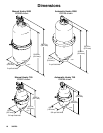
10 308703
Service
Bladder Failure
Normal life for bladders can be from a few months to
several years, depending upon the harshness of the
application. Below are common reasons for failed
bladders or bellows:
D Chemical attack: Check chemical compatibility
charts. Consult your Graco distributor.
D Cut bladder or bellows: Check for sharp objects
that may have been introduced into the surge
suppressor through pumped fluid.
D Insufficient compressed air charge in surge sup-
pressor during operation: See Charging and
Startup on page 8.
D Surge suppressor too small for the pump: An
undersized surge suppressor will have premature
bladder failure. Contact your Graco distributor for
assistance in ensuring that you have the correct
size surge suppressor.
Replacing Bladder or Bellows
1. Relieve the pressure.
WARNING
To reduce the risk of serious injury whenever you
are instructed to relieve pressure, always follow the
Pressure Relief Procedure on page 7.
2. Remove the clamp band, ring flange, or bolts.
3. Remove the top housing of the surge suppressor.
4. Remove the old bladder or bellows, and replace it
with the new bladder or bellows.
Make sure that you properly orient the parts:
D Install rubber bladders with the concave side
facing the top housing, as shown in the Parts
Drawings on page 14.
D Install PTFE bellows with the concave side
facing the bottom housing, as shown in Model
No. 239126 in the Parts Drawings on
page 15. Install the PTFE encapsulated fluo-
roelastomer o-rings on each side of the bel-
lows.
5. Replace the top housing of the surge suppressor.
6. Replace the clamp band, ring flange, or bolts, and
torque according to the torque specifications in the
Torque Table on page 11.






